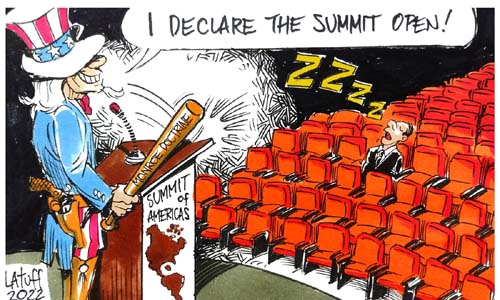
Slim chance for US to be successful in Summit of Americas
Andrey Kortunov
The US hosted the Summit of the Americas only once – it was the very first meeting of the forum conveyed in Miami in December of 1994. These were the heydays of the post-Cold War US international hegemony and the US global triumphalism.
Not surprisingly, the Clinton administration fully dominated in setting both the specific agenda of the event in Florida and the priorities for the new gathering at large. This was the time, when liberal models were swiftly spreading across Latin America; communist Cuba was almost completely marginalized in the continental politics and seemed to be very close to a regime change. Participants to the summit in Miami enthusiastically agreed to work on the Trade Area of the Americas (FTAA) as well as to promote democracy and prosperity in the continent, to fight corruption in all its forms and to eliminate illegal drugs trafficking.
Even then, these goals turned out to be exceedingly hard to reach. The implementation of FTAA encountered many roadblocks and failed to meet the deadline of 2005; the US preferred to shift its focus from trying to achieve a multilateral arrangement to negotiating bilateral trade deals with select Southern neighbors. Corruption and drug traffic were never eliminated in the Western Hemisphere, with both evils turning out to be more tenacious and adaptive than had been previously anticipated. Extreme poverty in the continent is on rise today, having reached by the end of 2021 almost 14 percent of the population. The communist Cuban political regime, contrarily to all apocalyptical predictions, demonstrated a remarkable resilience and successfully survived the generational leadership change. Moreover, since 1994 the balance of power in the world has changed quite dramatically to the detriment of the US former omnipotence; the romantic illusions of the borderless liberal globalization, the “end of history” and the “unipolar world” gave way to more realistic projections of maturing multipolarity and advancing regionalization in international relations.
Has Washington learnt the lessons of 1994? The forthcoming Ninth Summit of the Americas to be held in Los Angeles on June 6-10, 2022 should provide an answer to this question. However, the preparation of the summit raises doubts about US readiness to reassess its traditional approaches to Latin America. Twenty eight years ago, the Clinton administration, being at the very peak of US international power, blocked only Cuba from being present in Miami. Today, a much weaker Biden administration intends to exclude from participating not only Havana, but also Caracas and Managua. The case of Caracas is particularly surprising, given the recent persistent attempts by the White House to talk Venezuela into replacing Russia as a major oil supplier to the US.

This arbitrary selectivity in invitations has already raised legitimate concerns in Latin America and even questioned the readiness of some prominent Latin American leaders to join the event in Los Angeles. However, the problem is not limited to participation only. There are strong reasons to believe that the Biden administration will try to accomplish two prime missions at the ninth summit. First, to try and get unanimous Latin American support for the current US stance against Moscow. Second, to make Latin America choose between Washington and Beijing in favor of the former.
Neither of these missions are likely to be easily accomplished. Most of Latin American countries have no intention to turn the Russian-Ukrainian conflict into their top foreign policy priority. Some of them might be very critical of the Kremlin’s special military operation, but most of them – including such major powers as Brazil, Mexico and Argentina – are reluctant to impose harsh economic sanctions on Moscow. On the contrary, they often consider anti-Russia sanctions coming from the West as an opportunity to fill the vacuum and get stronger positions in Russia’s markets. Besides, they simply do not like the White House to teach them about what they should or should not do in international affairs. And, indeed, who among leaders of sovereign states would like to become an obedient schoolboy drilled by a demanding teacher?
With China, the chances for US to be successful in LA are even lower. Over 28 years China has turned from a non-entity in Latin America into a real economic power-house. The growth of its trade with the continent is truly astonishing: Between 2000 and 2020, Chinese trade with Latin America increased from 1.7 percent to 14.4 percent of the region’s total trade and was close to $450 billion in 2021. More than 20 Latin American and Caribbean countries signed on to China’s Belt and Road Initiative; six of them joined the Beijing-based Asian Investment and Infrastructure Bank. The mere idea of Latin American countries having to choose between China and US today looks odd, if not preposterous.
No doubt, the US will continue to be an important player in Latin America. Its relations with the Southern neighbors have a very long track record and pose an immense breadth. US soft power in the region still exceeds that of any other non-regional player. The US has numerous and vibrant Latin American diasporas. Maybe, the meeting in Los Angeles will make a valid contribution to managing transnational migrations in the Western Hemisphere, to promoting sustainable development goals and coping with the climate change challenge. But in order to be successful, the Biden administration has to drop its old habits of superpower arrogance and to address multiple real needs and concerns of US neighbors. As ancient Chinese philosopher Lao Tzu put it, “be the Chief, but never the Lord.” Washington still has to muster the art of the chiefdom in the region that used to be the US imperial backyard.
The writer is a director general of the Russian International Affairs Council
